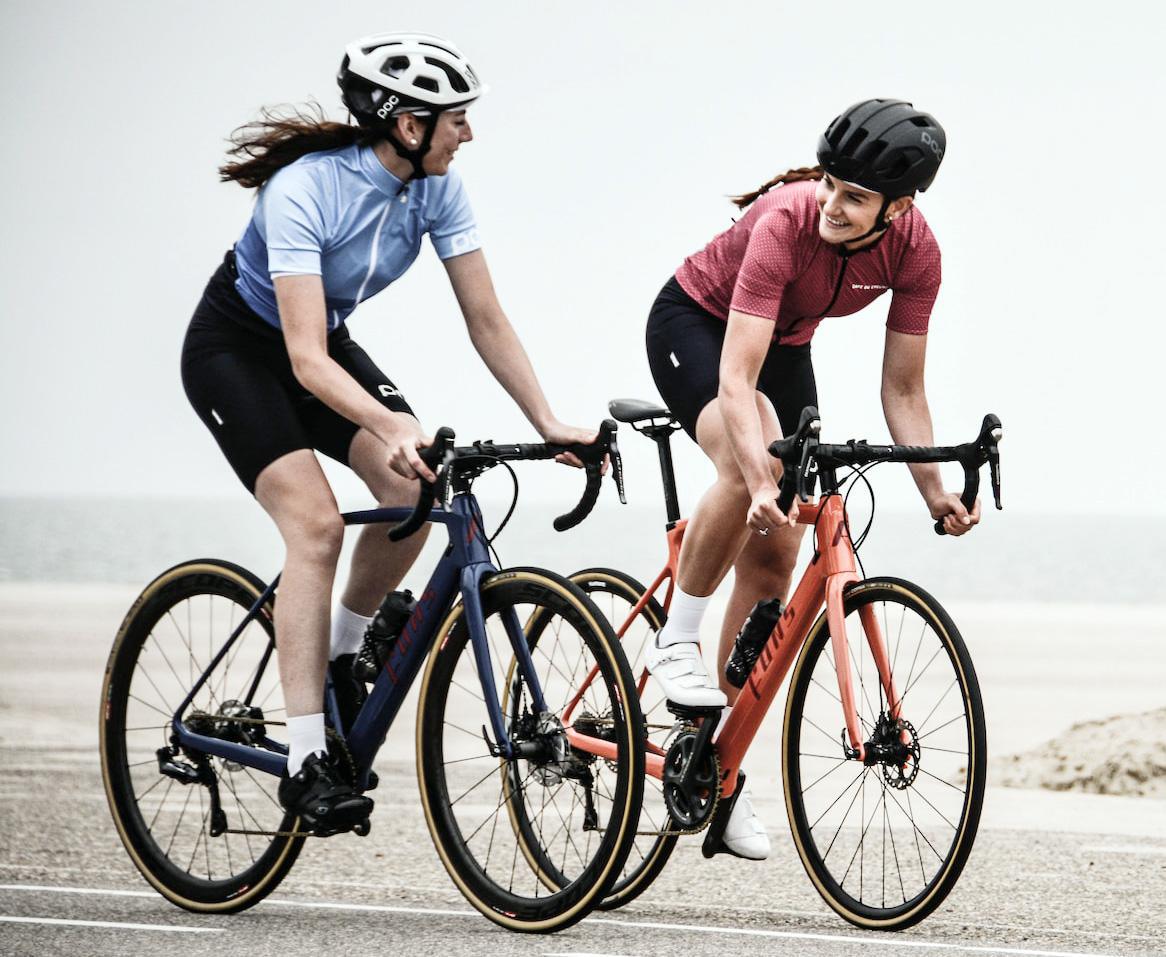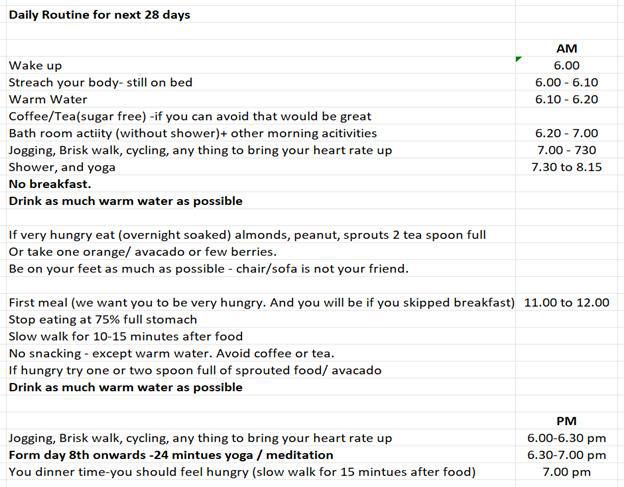21 + 7 preparatory days
(More details - www.diabetes21.com)
(Disclaimer: The information provided in this article is for educational and informational purposes only and is not intended as medical advice. It is not a substitute for professional medical advice, diagnosis, or treatment. Always seek the advice of your physician or other qualified healthcare providers with any questions you may have regarding a medical condition or treatment before undertaking a new healthcare regimen. Never disregard professional medical advice or delay seeking it because of something you have read in this article).
Before we jump on to the 21-day program, it is suggested to do a 7-day preparatory process to iron out any issue one might face. Please follow all ten steps during seven preparatory days except for the evening 24 minutes of yoga/meditation.
I am not suggesting any magic solution here. Simple activities done consistently with discipline can bring magical results.
For this program, we are following 16:8 intermittent fasting, meaning, if we eat our dinner at 7.00 pm, we will not eat any food for the next 16 hours (other than the suggested food) until the next day at 11.00 am. We can eat during the 8 hours of 11.00 am to 7.00 pm—more details in Step 8.
By the end of 28 days, you can expect the following:
- You will lose some weight - if you strictly follow the below ten steps, you will surely lose weight
- You will feel more energetic - no need to avoid those extra climbing steps.
- You could give up diabetes medication entirely or go on a reduced dosage. I was on diabetic medication for 20 years. In July 2020, I did this program and have been off the diabetic medication since then. My recent A1C was 5.9 (read my story). But consult your doctor before making any changes to your prescription.
First, check the following and record the numbers:
a. Check your A1C _______________% (more more on A1C)
Talk to your doctor or a nearby blood testing lab if you do not know your A1C.
b. Check your BMI_________________ (more on BMI)
You can check your BMI by inputting your height and weight on this website: https://www.nhlbi.nih.gov/health/educational/lose_wt/BMI/bmicalc.htm
(Please continue with all your current medication during the program. After the program or close to the end, if your blood sugar reading is low (below 100), work with your doctor if required to reduce medication).
Step 1: Morning on wake up – still in bed – do the following simple stretching – 7 minutes
If you have the practice of emptying your bowels upon waking up, please do so before stretching.
1.1 Extend your hands backward as much as possible, stiffen your body, stretch your ankle, and extend your feet forward. Do this seven times.
1.2 Bend your right knee and pull it towards your stomach, as much as you can, using both hands and release it back. Now bend your left knee and pull it towards your stomach, as much as you can, using both hands and release it back– it is one cycle. Repeat seven times.
1.3 Lift your right leg (with palms facing the bed), bring it towards your face as much as possible, and slowly release it back. Then lift your left leg, bring it towards your face as much as possible, and gradually get it back- one cycle. Repeat seven times.
1.4 With your palms on the bed, bring your legs up and cycle(like you would ride a bicycle)- a minimum of twenty cycles.
1.5 With palms on the bed, bring both legs up, move towards your face as much as possible, and bring both legs back slowly – seven times.
Step 2: Drink warm water – Drink one cup of warm water- sit on a chair and drink slowly.
Step 3: Coffee/Tea:
If you drink coffee or tea, take it without sugar. (If you can avoid coffee/tea, please do so). I drink coffee after water to get my gut/bowel system working.
Step 4: Finish bathroom activities (excluding shower)
Step 5: Exercise/ Physical activity
Next 30 minutes, brisk walk, jog, combine walk and jog, ride a bicycle (strongly recommended), do sports activity, or do anything that brings up the heartbeat. The objective is to sweat out and increase heartbeat.
Step 6: Shower
Step 7: Yoga/meditation:
Twenty-four minutes of Yoga meditation - follow the link to the video below. It is suggested to keep the stomach empty; water is allowed, but no food (more on yoga/meditation).
7.1 Butterfly / Titli – 2 min
7.2 Sisupala – right leg - 2 min
7.3 Sisupala – left leg - 2 min.
https://www.youtube.com/watch?v=A7YQ_bkdUgo&t=263s
7.4 Cat stretch/ Nadi Vibha Jana – 3 min (3 cycles)
https://www.youtube.com/watch?v=hbe0820DFaA&t=218s
7.5 Kapalbhati – 3 min
7.6 Bhastrika – 3 min
7.7 Alternate breathing – 3 min
7.8 Bramhamari – 3 min
7.9 Relax – 3 min
https://www.youtube.com/watch?v=ZT-HDh7pjC4&t=115s
(Video courtesy: Namaste Yoga)
After yoga/ meditation, go about your daily work life. We are following 16:8 intermittent fasting. During work, try to stay on your feet as much as possible (if you can get a standing desk, great). Your chair is not your best friend. If you have to sit and work, try getting up every 30 minutes and walking for a minimum of 5 minutes.
We want you to get tired and feel hungry, for real, by lunchtime. If you are starving before lunch and need to eat, take two teaspoonfuls of overnight-soaked almonds, peanuts, beans, sprouted greens, avocado, etc. According to the study, on average, a person can survive without food for 3 to 4 weeks. So 16 hours without food cannot harm you unless medically advised otherwise.
Step 8: Lunch 11-12 pm
If 11-12noon is not feasible, you can choose your time but maintain 16:8 intermittent fasting. The key is to select food that will not convert to glucose (sugar) immediately or foods that delay the conversion to glucose on consumption.
Check your blood sugar before lunch and record it.
To avoid blood-sugar spikes, start with low GI (glycemic index) food such as vegetables, followed by protein, and then by carbohydrates.
Liquids:
8.1 The only liquid I would stick to during this program would be water, preferably warm or lukewarm water, a lot of it. If your urine is not colorless, you are not drinking enough water.
8.2 Avoid all drinks, diet, energy, flavored, and anything bottled, packed, or pre-processed.
8.3 Instead of fruit juices, eat fruits good with fiber - apples, berries, pears, avocado (my favorite), etc.,
8.4 Avoid alcohol during the program. I do drink a glass of wine occasionally but not during the program.
Foods:
8.5 Avoid all foods with sugar, sugar substitutes, or zero-sugar (diet) alternatives.
8.6 Avoid all foods that come processed, packed, tinned, or wrapped; you get my point.
8.7 The key to selecting food is - low carb, zero sugar, high protein, and fiber. If you look online, you get plenty of options.
8.8 Try multi-grain, millet, quinoa, oats, rye, brown rice, etc., which are low GI (glycemic index).
8.9 Greens and vegetables, non-starchy low on carbs, and high on fiber
8.10 Legumes, pulses, lentils, beans, etc., high in protein and fiber
8.11 Nuts - almonds, chia seeds, flax seeds, walnut, pistachio, cashew, brazil nuts, etc.
8.12 Fruits - apples, berries, pears, avocados, prunes, peaches, etc.
8.13 Consume as much freshly cooked food as possible. I would avoid storing cooked food for later consumption.
8.14 Lean proteins such as skinless chicken, fish, and tofu are excellent protein sources. However, I would avoid chicken/meat during the program for two reasons - It takes 24 hours plus for non-vegetarian food to digest compared to a couple of hours for vegetarian food. A clean gut and bowels bring in more energy and keep one more active, and for maximum benefits of yoga/meditation, it is required to keep the stomach empty.
Quantity to consume and after-meal activity:
8.15 For lunch, fill your stomach 75% only. Drink the minimum required water during lunch.
8.16 After lunch, do not sit down; stroll for a minimum of 10 minutes; drink as much warm/lukewarm water as possible after the walk.
8.16 To avoid blood-sugar spikes, start with low GI (glycemic index) food such as vegetables, followed by protein, and then by carbohydrates.
No food till dinner time. If you need to snack, take one or two spoons of soaked almond, peanut, beans, sprouted green, or other grams, or try a fruit – apple, avocado, berries, pear, all in moderation.
Step 9: Before dinner - Exercise and Yoga
9.1 For 30 minutes, engage in physical activity/exercise—a brisk walk, jog, run, sports, or movement that increases your heart rate.
9,2 Yoga/ Meditation – 24 minutes (required for 21-day program) - Keep your stomach empty for the Yoga/meditation.
Step 10: Ready for dinner:
Dinner around 7 pm or as per your plan keeping a 16:8 intermittent fasting schedule. Try as much uncooked food as possible for dinner, like salad (zero dressings), soaked nuts, and steamed vegetables. If cooked, try steamed vegetables, gram/protein-based pancakes, chutneys, etc. Eat as light as you possibly can. Keep a 50% to 70% full stomach. Sleep any time after 2/3 hours after dinner.
(More details - www.diabetes21.com)
Blood sugar chart for the next 28 days
This is your progress barometer for the next 28 days. Please check your blood sugar levels before lunch and dinner every day for the next 28 days and record them to monitor your progress.
Your Daily routine would look like this. I have started the day at 6.00 am, and you can make up your schedule according to your convenience, but ensure that 16:8 intermittent fasting is followed:







